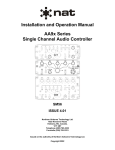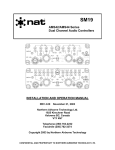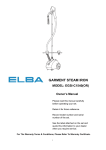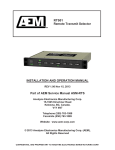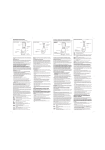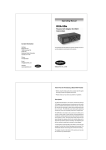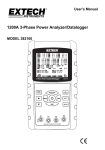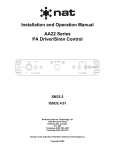Download AMS43 Single Channel Audio Controller
Transcript
SPECIAL NOTICE This product is now licensed to Anodyne Electronics Manufacturing (AEM) from Northern Airborne Technology (NAT). AEM is responsible for all matters related to this product, including sales, support and repair services. Please note the transition to convert product manuals and supporting documentation is an ongoing process and is being addressed on an ‘as needed’ basis. All references to NAT product part numbers (and associated images) are equivalent to AEM product part numbers. Contact info: Anodyne Electronics Manufacturing Corp. #15-1925 Kirschner Road Kelowna B.C. Canada V1Y 4N7 Email: [email protected] Toll Free: 1-888-763-1088 Phone: 1-250-763-1088 Fax: 1-250-763-1089 www.aem-corp.com SM59 AMS43 Single Channel Audio Controller INSTALLATION AND OPERATION MANUAL Rev: 2.00 April 22, 2012 Anodyne Electronics Manufacturing Corp. 15-1925 Kirschner Road Kelowna, BC, Canada. V1Y 4N7 Telephone (250) 763-1088 Facsimile (250) 763-1089 Website: www.aem-corp.com © 2012 Anodyne Electronics Manufacturing Corp. (AEM), All Rights Reserved CONFIDENTIAL AND PROPRIETARY TO ANODYNE ELECTRONICS MANUFACTURING CORP. AMS43 Single Channel Audio Controller SM59 Installation and Operation Manual IMPORTANT INFORMATION This manual has been produced to provide information unique to the AMS43 Single Channel Audio Controller. Some of this information has been published previously in the SM01 Service manual (AA90/AMS40 Series Audio Controllers). Earlier versions of the AMS43 may not be covered by the information in this manual. Please refer to SM01, or contact the Technical Support Department at AEM. COPYRIGHT STATEMENT © 2012 Anodyne Electronics Manufacturing Corp. (AEM), All Rights Reserved This publication is the property of AEM and is protected by Canadian copyright laws. No part of this document may be reproduced or transmitted in any form or by any means including electronic, mechanical, photocopying, recording, or otherwise, without the prior written permission of AEM. Installation and Operation Manual Page ii ENG-FORM: 820-0100.DOTX CONFIDENTIAL AND PROPRIETARY TO ANODYNE ELECTRONICS MANUFACTURING CORP. AMS43 Single Channel Audio Controller SM59 Installation and Operation Manual Prepared By: Checked By: Tony Pearson Designer Apr 22, 2012 Approved By: Tom Betzelt Product Support Manager May 28, 2012 Loen Clement Designer May 24/12 The status of this installation and operation manual is controlled by issue shown on the title page. The status of each section is controlled by revision shown in the footer of each page. All revisions affecting sections of this manual have been incorporated into the latest issue. ISSUE/REVISION RECORD Manual Issue Number Section Revision Number Revision Description Issue Date 4.00 N/A N/A Nov 10, 2003 4.01 Section 1 Rev: 1.00 Section 2 Rev: 1.00 Section 3 Rev: 1.00 Rewritten in latest format. Newest drawings added. Sep 23, 2008 AEM MANUAL REVISIONS Section Revision Number Revision Description Date All Rev: 2.00 Updated drawings and format April 22, 2012 Installation and Operation Manual Page iii ENG-FORM: 820-0100.DOTX CONFIDENTIAL AND PROPRIETARY TO ANODYNE ELECTRONICS MANUFACTURING CORP. AMS43 Single Channel Audio Controller SM59 Installation and Operation Manual Table of Contents Section Title 1.0 Description 1.1 1.2 1.3 1.4 1.4.1 1.4.2 1.4.3 Introduction Purpose of Equipment Design Features Specifications Electrical Specifications Physical Specifications Environmental Specifications 2.0 Installation 2.1 2.2 2.2.1 2.3 2.4 2.4.1 2.4.2 2.4.3 2.4.4 2.5 2.5.1 2.5.2 2.5.3 2.6 2.7 Introduction Unpacking and Inspection Warranty Continued Airworthiness Installation Procedures Warnings Cautions Cabling and Wiring Post Installation Checks Adjustments and Connections Left Side panel adjustments Right Side Panel Adjustments In-line PTT Drop Cords Accessories Required But Not Supplied Installation Drawings 3.0 Operation 3.1 3.2 3.3 3.3.1 3.3.2 3.3.3 3.4 3.5 3.5.1 3.5.2 Introduction General Information Controls and Indicators Receive Audio Select Switches Transmit Selector Switch ICS Functions Emergency Operation Audio Alerting Functions Direct Audio Internal Alerting Installation and Operation Manual Page 1-1 1-1 1-1 1-2 1-2 1-3 1-4 2-1 2-1 2-1 2-1 2-1 2-1 2-2 2-2 2-2 2-3 2-4 2-4 2-5 2-6 2-7 3-1 3-1 3-1 3-1 3-2 3-3 3-4 3-4 3-4 3-4 Page iv ENG-FORM: 820-0100.DOTX CONFIDENTIAL AND PROPRIETARY TO ANODYNE ELECTRONICS MANUFACTURING CORP. AMS43 Single Channel Audio Controller SM59 Installation and Operation Manual Section 1.0 Description 1.1 Introduction Information in this section consists of product description, design features and specifications for the AMS43 Single Channel Audio Controller. All derivative product information shall be contained in the applicable manual supplement, which may be obtained from AEM as required. Review all notes, warning and cautions. 1.2 Purpose of Equipment The AMS43 provides control of aircraft audio, allowing selection of transmit (TX) and receive (RX) audio, LIVE, KEYED, or voice activated (VOX) intercom, interface for an additional hand-held transmit microphone (hand mic), and pilot isolation/emergency (ISO/EMR) operation. TX and PA functions are controlled with a single rotary switch. RX audio, intercom (ICS) operations and tape audio are controlled with toggle switches. RX volume, ICS volume and ICS VOX squelch are individually adjusted with rotary controls. Sidetone (S/T) level is adjustable internally. 1.3 Design Features The AMS43 is a Dzus rail mounted unit with a backlit faceplate. Transceiver interfacing is accomplished through directly switched microphones. To ensure maximum radio compatibility, it has a ground referenced keyline that does not incorporate diodes or other steering components. Independent control is provided for S/T, ICS audio, and RX audio. Boom mic support is provided for the pilot and co-pilot, with both ICS and TX functions via cyclic or yoke switching. Live (Hot Mic) and VOX ICS allow immediate transmission without additional control panel switching, with immediate return to ICS operation on completion. The ICS function is achieved using dynamic noise reduction and active filtering. This provides the clearest possible ICS audio under high ambient noise conditions by rejecting airframe and wind noise, and passing only voiceband information. All audio, except the S/T of the radio in use and DIRECT AUDIO 2 input signals, is muted during TX for clarity. ICS operation allows TX during any ICS mode by using the TX push-to-talk (PTT) switch. All external interconnect, switches and relay contacts are gold plated for maximum reliability. Switches and relays are sealed. G10-FR flame-retardant circuit boards are postcoated for maximum moisture resistance and corrosion prevention. Relays are sealed, high vibration rated (50g shock), dry nitrogen filled units. April 22, 2012 Rev: 2.00 Page 1-1 ENG-FORM: 800-0100.DOTX CONFIDENTIAL AND PROPRIETARY TO ANODYNE ELECTRONICS MANUFACTURING CORP. AMS43 Single Channel Audio Controller SM59 Installation and Operation Manual 1.4 Specifications 1.4.1 Electrical Specifications Input Power 27.5 Vdc Nominal 0.50 A Max. Lighting Voltage 27.5 Vdc @ 160 mA Alert Power 27.5 Vdc Nominal 150 mA Max. Quantity 13 Receive channels. 7 Mic channels 1 ICS tie channel 2 direct channels Audio level 2.5V rms for receiver inputs. 0.25V rms for mic inputs. 0.34V rms for ICS tie input. 2.5V rms for direct audio inputs. Impedance 1k: ± 10% for receive inputs. 1k: ± 10% for mic inputs. 1.8k: ± 10% for ICS tie input. 1.3k: ± 10% for Direct Audio 1 input. 100: ± 10% for Direct Audio 2 input. Circuitry Type All are Single ended inputs. Coupling < -50 dB Key lines Pilot & Copilot Transmit PTT. Rear Hand mic Transmit PTT Pilot & Copilot ICS PTT. 3 Alerts - active low. Quantity 6 Headset outputs. 6 Transmitter mic outputs. 5 Transmitter keyline outputs. Input Signals Output Signals Rated level Headset Direct Audio1 Direct Audio 2 Alert level Impedance Circuitry Type Freq. Response Sidetone April 22, 2012 Rev: 2.00 7.7 Vrms or 100 mW (20 dBm) into 600 : 10 mW (10 dBm) into 600 : 0.1 mW (-10 dBm) 0.25 Vrms into 600 : 90mV rms ±10% into 600 : 65 : Max Single-ended, except for phones, which are balanced. <3 dB from 650 Hz to 1750 Hz Page 1-2 ENG-FORM: 800-0100.DOTX CONFIDENTIAL AND PROPRIETARY TO ANODYNE ELECTRONICS MANUFACTURING CORP. AMS43 Single Channel Audio Controller SM59 Installation and Operation Manual Receive inputs 1.4.2 <3 dB from 500 Hz to 2200 Hz Intercom Alert 1 Alert 2 Alert 3 < 3 dB from 550 Hz to 2400 Hz. 1.5kHz + 20% Same tone as Alert #1 but swept @ 2 cycles/sec. Approx. same as Alert 2 but on for 2 sec. Distortion < 10% THD @ rated power output Audio Noise Level: < -50 dB Coupling < -50 dB Output Regulation < 10% distortion and <3 dB max. of rated load output power at 400% and 75% of rated load Annunciators Green LED will light for transmit operation. Physical Specifications Height 1.90” (48.3 mm) Depth 6.82” (173.2 mm) Width 5.00” (125.0 mm) behind panel Weight 2.1 lbs (955g) Mounting Dzus rail Faceplate Engraved acrylic edge lit panel Material/Finish Chassis & cover are 5052-H32 brushed aluminum with conversion coating finish Connectors Male 50 pin & 37 pin D-submin connectors with slide locks April 22, 2012 Rev: 2.00 Page 1-3 ENG-FORM: 800-0100.DOTX CONFIDENTIAL AND PROPRIETARY TO ANODYNE ELECTRONICS MANUFACTURING CORP. AMS43 Single Channel Audio Controller SM59 Installation and Operation Manual 1.4.3 Environmental Specifications DO-160C Env. Cat. B1-CANXXXXXXABABBBBXXX Operating Temperature -20q C. to +55q C Survival Temperatures -55q C. to +85q C Vibration/Shock DO-160C Cat. N Humidity 95% Altitude 25,000 feet max End of Section 1.0 April 22, 2012 Rev: 2.00 Page 1-4 ENG-FORM: 800-0100.DOTX CONFIDENTIAL AND PROPRIETARY TO ANODYNE ELECTRONICS MANUFACTURING CORP. AMS43 Single Channel Audio Controller SM59 Installation and Operation Manual Section 2.0 Installation 2.1 Introduction Information in this section consists of unpacking and inspection procedures, installation procedures, postinstallation checks and installation drawings for the AMS43 Single Channel Audio Controller. Review all notes, warnings and cautions. 2.2 Unpacking and Inspection Unpack the equipment carefully. Inspect the unit visually for damage due to shipping and report all such claims immediately to the carrier involved. Check that all items listed below are present before proceeding and report any shortage immediately to your supplier: - AMS43 Single Channel Audio Controller - Product Information Card - Certificate of Conformity or Release Certification 2.2.1 Warranty All Anodyne Electronics Manufacturing Corp. (AEM) products are warranted for 2 years. See the website www.aem-corp.com/warranty for complete details. 2.3 Continued Airworthiness Maintenance of the AMS43 Single Channel Audio Controller is ‘on condition’ only. Periodic maintenance of this product is not required. 2.4 Installation Procedures 2.4.1 Warnings WARNING: High volume settings can cause hearing damage. Set the headset volume control to the minimum volume setting prior to conducting tests, and slowly increase the headset volume to a comfortable listening level. April 22, 2012 Rev: 2.00 Page 2-1 ENG-FORM: 805-0100.DOTX CONFIDENTIAL AND PROPRIETARY TO ANODYNE ELECTRONICS MANUFACTURING CORP. AMS43 Single Channel Audio Controller SM59 Installation and Operation Manual 2.4.2 Cautions CAUTION: Do not bundle any lines from this unit with transmitter coax feed lines. Do not bundle any logic, audio, or DC power lines from this unit with 400 Hz synchro wiring or AC power lines. Do not position this unit next to any device with a strong alternating magnetic field such as an inverter, motor or blower, or significant audio interference will result. In all installations, use shielded cable exactly as shown, and ground only as indicated. Significant problems may result from not following these guidelines. Failure to follow the installation and wiring instructions provided in this manual for power and ground connections, including the rating of the circuit breaker, may lead to damage in the power input circuitry of the unit. 2.4.3 Cabling and Wiring All wire shall be selected in accordance with the original aircraft manufacturer's Maintenance Instructions or AC43.13-1B Change 1, Paragraphs 11-76 through 11-78. Unshielded wire types shall qualify to MIL-W-22759 as specified in AC43.13-1B Change 1, Paragraphs 11-85, 11-86, and listed in Table 11-11. For shielded wire applications, use Tefzel MIL-C-27500 shielded wire with solder sleeves (for shield terminations) to make the most compact and easily terminated interconnect. Follow the connector map in Section 2.7 as required. Allow 3" from the end of the shielded wiring to the shield termination to allow the connector hood to be easily installed. Reference the interconnect drawing in Section 2.7 for shield termination details. Note that the hood is a "clamshell" hood, and is installed after the wiring is complete. Aircraft harnessing shall permit the unit to be removed from the panel for easy access to all side adjustments. Do NOT mount the unit until all adjustments have been performed. Maintain wire segregation and route wiring in accordance with the original aircraft manufacturers Maintenance Instructions. Unless otherwise noted, all wiring shall be a minimum of 22 AWG, except power and ground lines, which shall be a minimum of 20 AWG. Reference the Interconnect drawing for additional specifications. Check that the ground connection is clean and well secured, and that it shares no path with any electrically noisy aircraft accessories such as blowers, turn and bank instruments or similar loads. Power to this unit must be supplied from a separate circuit breaker or fuse (fast blow), and not attached to any other circuit breaker without additional protection. Verify that the selected circuit breaker size and wire gauge are adequate for the installation using the techniques specified in AC43.13-1B Change 1, Paragraphs 11-47 through 11-51 and 11-66 through 11-69. 2.4.4 Post Installation Checks Perform any required adjustments of preset levels, and ensure that the audio controller is properly mounted and secured prior to flight. April 22, 2012 Rev: 2.00 Page 2-2 ENG-FORM: 805-0100.DOTX CONFIDENTIAL AND PROPRIETARY TO ANODYNE ELECTRONICS MANUFACTURING CORP. AMS43 Single Channel Audio Controller SM59 Installation and Operation Manual 2.4.4.1 Voltage/Resistance Checks Do not attach the AMS43 until the following conditions are met. Check the following: a) P101 pins <16> and <17> for +28 Vdc relative to ground. b) P101 pin <34> for continuity to ground (below 0.5 c) P102 pin <19> for +28 Vdc lights bus voltage. d) Check all Mic, phone, music and key lines for shorts to ground or adjacent pins. 2.4.4.2 ). Power On Checks Power up the aircraft’s systems and confirm normal operation of all functions of the AMS43. Refer to Section 3 (Operation) for specific operational details. Start with only the pilot's headset installed. Check for correct Intercom (ICS), radio, and transmit (TX) operation. Do not proceed until the radios are functioning correctly. The S/T trimpot accessible through the left side of the controller and the transceiver internal trimpot may have to be adjusted for correct balance for the pilot. Adjustment of the individual radio receive (RX) levels should be set first with the AMS43 in PILOT ISO/EMR (Pilot isolate/emergency) mode, then adjust the AMS43 front panel RX master volume control level in NORMAL mode. Unusual buzzes, hums or other background audio are symptomatic of multiple grounds or noisy external systems sharing the same wire bundle. Incorrect jack wiring is a common fault, especially for passenger stations, and may cause loss of audio, a tone on the headset lines, or other problems. Failure to key or correctly modulate a transceiver may be caused by missing grounds on the radio or audio controller. Plug in the hand mic and test for correct operation. Wiring faults for this accessory may cause peculiar loss of ICS or TX functions because it has over-riding priority in the system. Plug in the remaining headsets and check for proper operation. An incorrect drop cord or improper jack wiring may cause a wide range of problems from loss of audio to a tone heard in the headset. For further information, see section 2.5.3 below. Check levels and operation of all functions in flight to ensure proper adjustments and settings have been made. Upon satisfactory completion of all performance checks, make all required log book entries, electrical load, weight and balance amendments and other documentation as required by your local regulatory agency before releasing the aircraft for service. 2.5 Adjustments and Connections The unit ships from the factory with all internal adjustments set to the normal test levels. Once installed in the aircraft, it may be desirable to change some of these settings to best suit the local operating environment. The internal adjustments are located on the sides of the unit and are as follows: April 22, 2012 Rev: 2.00 Page 2-3 ENG-FORM: 805-0100.DOTX CONFIDENTIAL AND PROPRIETARY TO ANODYNE ELECTRONICS MANUFACTURING CORP. AMS43 Single Channel Audio Controller SM59 Installation and Operation Manual 2.5.1 Left Side panel adjustments The trimpots on the left side panel are used to adjust the levels of audio in the user’s headphones. Rotating the trimpots clockwise (cw) increases the level, and counterclockwise (ccw) reduces it. The ALERT LEVEL trimpot is used to adjust the levels for the three internally generated Alert signals. Other parameters relating to these signals are adjusted from the right side panel (see section 2.3.4.2.) The S/T LEVEL trimpot adjusts the internal gain of the sidetone (S/T) of the selected transceiver (from the front panel) in the user’s headphones. The VOX LEVEL trimpot sets the sensitivity level for the front panel VOX control (the level of audio required to activate microphones). The POWER ON LED will illuminate to indicate that the unit is connected to the power supply. 2.5.2 Right Side Panel Adjustments A variety of different signals can be selected to trigger the internal Alert signals. The trimpots on the right side panel are used to adjust the characteristics of the audible signals that the user will hear. Audio Alert 1 is a single tone signal and Audio Alerts 2 and 3 are two-tone signals. The pitch of the signals can be adjusted using the relevant TONE trimpot, and the cycling rate of the two-tone signals can be adjusted using the RATE trimpots. The duration of Audio Alert 3 can be adjusted from one to three seconds using the TIME trimpot. The DIR AUD LEVEL trimpot is used to adjust the audio level of the devices connected to the DIR AUD 1 input. April 22, 2012 Rev: 2.00 Page 2-4 ENG-FORM: 805-0100.DOTX CONFIDENTIAL AND PROPRIETARY TO ANODYNE ELECTRONICS MANUFACTURING CORP. AMS43 Single Channel Audio Controller SM59 Installation and Operation Manual 2.5.3 In-line PTT Drop Cords 2.5.3.1 General In-line, push-to-talk (PTT) drop cords (also known as cordsets) can be used to create/provide PTT capability for the user headsets that do not have yoke or cyclic mounted PTT switches. For headsets connected to the PILOT or COPILOT inputs/outputs of the AMS43, ICS and TX keylines are needed to properly activate the associated PTT circuitry inside the AMS43. For headsets connected to the PASSENGER inputs/outputs of the AMS43, a method of controlling the microphone on the headset is needed because of the 'hot mic' circuitry. This is best accomplished with a 'mic interrupt' switch in the PTT drop cord. There are numerous manufacturers of in-line PTT drop cords, offering many 'electrical' variations to accomplish different functions. To meet the operational requirements for headset stations supported by the AMS43, AEM recommends the dual switch type: a 3-position (momentary/center-off/locking) slider switch for the ICS functions, and a momentary, push-button switch for the TX functions. Both switches provide a ‘mic interrupt’ function. The 3-position ICS switch will allow the user to change the switch settings to match the operational intercom mode that has been selected at the AMS43 (e.g., LIVE, KEYED or VOX). The cable should have 6 conductors, with the MIC and PHONE pairs shielded (MIC wires must be shielded as a minimum). To ensure proper shielding, the shield(s) should be terminated to the MIC LO connection at the airframe connector of the PTT drop cord. See the drawing below for details. PTT Cord for Use with AEM Audio Controllers (XMIT and ICS) To avoid complications in the aircraft, it is recommended that the same type of PTT drop cord is used for all headset locations in the aircraft. It is not good practice to create a situation where a specific drop cord is needed for the copilot, which might cause operational errors if moved to a passenger location. April 22, 2012 Rev: 2.00 Page 2-5 ENG-FORM: 805-0100.DOTX CONFIDENTIAL AND PROPRIETARY TO ANODYNE ELECTRONICS MANUFACTURING CORP. AMS43 Single Channel Audio Controller SM59 Installation and Operation Manual 2.5.3.2 Cautions CAUTION: Although in-line PTT drop cords can be used to conveniently address a number of requirements for microphone and PTT control, they can also be a source of trouble if incorrectly configured, or improperly shielded. Many in-line PTT drop cords use the PHONE LO connection as the ground reference for the ICS and TX PTT keylines. The PHONE LO connection in the AMS43 is floating, which will lead to incorrect keying of the intercom and radio systems if this type of drop cord is used. In-line PTT drop cords can be a very real source for crosstalk if the MIC wire pair in the drop cord is not shielded. The source of the crosstalk is the high level Phones audio being coupled on to the MIC HI/LO pair in the in-line PTT drop cord, because of the lack of shielding for this wire pair. Once the mic line is contaminated, the undesired audio can be sent into the audio system as ‘mic audio’, then processed and distributed to all other audio controllers via the ICS Tie Line. 2.6 Accessories Required But Not Supplied Installation kit AA90-IKC (Alt. part No. D50S37SL-IKC) is required to complete the installation. The kit consists of one 50-Pin D-min Female Crimp Kit (D50SL-IKC) and one 37-Pin D-min Female Crimp Kit (D37SL-IKC). D50SL-IKC consists of Quantity 1 50 1* 1* 1 Description D-min 50 Socket Housing MS Crimp Socket Jack Screw Set Lock Clip Set 50 Pin Connector Hood AEM Part # 20-21-050 20-26-901 20-27-002 20-27-004 20-29-051 Description D-min 37 Socket Housing MS Crimp Socket Jack Screw Set Lock Clip Set 37 Pin Connector Hood AEM Part # 20-21-037 20-26-901 20-27-002 20-27-004 20-29-038 D37SL-IKC consists of Quantity 1 37 1* 1* 1 * Use as required. April 22, 2012 Rev: 2.00 Page 2-6 ENG-FORM: 805-0100.DOTX CONFIDENTIAL AND PROPRIETARY TO ANODYNE ELECTRONICS MANUFACTURING CORP. AMS43 Single Channel Audio Controller SM59 Installation and Operation Manual 2.7 Installation Drawings DRAWING AMS43\403-0 AMS43\403-1 AMS43\403-2 AMS43\405-0 AMS43\905-0 AMS43\922-0 REV. 1.12 1.12 1.12 1.00 2.00 1.01 DESCRIPTION Audio Controller Audio Controller Audio Controller Audio Controller Single Channel Audio Controller Audio Controller TYPE Interconnect Interconnect Interconnect Connector Map Faceplate Mech. Installation SERIAL No. 2580 and up 2580 and up 2580 and up 2580 and up 2580 and up 2580 and up Section 2.0 ends following the above documents April 22, 2012 Rev: 2.00 Page 2-7 ENG-FORM: 805-0100.DOTX CONFIDENTIAL AND PROPRIETARY TO ANODYNE ELECTRONICS MANUFACTURING CORP. 2.00 RX-ON COM 1 COM 2 PILOT ISO / EMER TX AUX FM1 FM2 LIVE NAV1 ADF1 DME NAV2 ADF2 MKR RX VOL ICS VOX TAPE ICS VOL KEY OFF RDB PA AMS43 NORMAL NOV 10/11 RAS #18 - CHANGED TO AEM LOGO, UPDATED HOLE SCHEDULE. COM1 KELOWNA BC CANADA (250)-763-1088 WWW.AEM-CORP.COM Nov 16/11 21 Nov 11 AUDIO CONTROLLER REV SIZE A AMS43 L9015 1:1 905-0 2.00 SHEET 1 of 3 Tony Pearson Designer Mar 7, 2011 AMS43 Single Channel Audio Controller SM59 Installation and Operation Manual Section 3.0 Operation 3.1 Introduction Information in this section consists of functional and operational procedures for the AMS43 Single Channel Audio Controller. 3.2 General Information The AMS43 provides control for all aircraft audio, allowing selection of transmit (TX) and receive (RX) audio, LIVE, KEYED, or voice activated (VOX) intercom, interface for an additional hand held transmit microphone (hand mic), and pilot isolation/emergency (PILOT ISO/EMR) operation. Sidetone (S/T) level is adjustable internally, and RX and intercom (ICS) levels are adjustable on the front panel. All audio, except the S/T of the radio in use and the directly connected DIRECT AUDIO 2 input signal (see Section 3.5.1), is muted during TX for clarity. ICS operation allows TX during any ICS mode by using the push-to-talk (PTT) switch. 3.3 Controls and Indicators All TX and public address (PA) functions are controlled with a single rotary selector switch. RX audio, ICS operations and tape audio are controlled with colour-coded toggle switches. RX volume, ICS volume and ICS VOX squelch are individually adjusted with rotary controls. 3.3.1 Receive Audio Select Switches Transceiver Receive Audio Select Switches Mode Switch NAV Aid Audio Select Switches Receive Volume Control The transceiver RX audio select switches (white switch bats) are two-position switches. When set to the up position, the respective transceiver RX audio is selected on. When set to the down position, the respective transceiver RX audio is selected off. April 22, 2012 Rev: 2.00 Page 3-1 ENG-FORM: 806-0100.DOTX CONFIDENTIAL AND PROPRIETARY TO ANODYNE ELECTRONICS MANUFACTURING CORP. AMS43 Single Channel Audio Controller SM59 Installation and Operation Manual The NAV RX audio select switches (blue switch bats) are three-position switches. When set to the up or down position, the respective NAV RX audio is selected on. When set to the center off position, the respective NAV RX audio is selected off. The master RX volume control (RX VOL) adjusts all RX audio concurrently from 1% to full. It is important to set the individual radio volume controls to a nominal level, and then use the master RX VOL control on the audio controller to adjust for changing flight conditions. When the red mode switch is set to NORMAL, the passengers will hear the radio audio as selected on the controller. The passengers will not hear any radio audio when the red mode switch is in the ISO/EMR position. 3.3.2 Transmit Selector Switch TX Indicator Transmit Selector Switch The TX selector switch is a six-position switch used to select the desired transceiver. When rotated fully clockwise, this switch selects the PA function. When the hand mic or TX PTT switch is activated, the mic will be coupled to the radio (or PA) selected. The pilot has priority over the copilot during TX operations. RX audio for the transceiver selected is automatically activated as a function of the rotary selector switch, and no additional switching is needed to establish outside communication. During TX, all audio selected is muted except the sidetone of the transceiver in use. The front panel TX indicator will illuminate green when either the pilot or co-pilot transmits. It will not light when the hand mic is used. April 22, 2012 Rev: 2.00 Page 3-2 ENG-FORM: 806-0100.DOTX CONFIDENTIAL AND PROPRIETARY TO ANODYNE ELECTRONICS MANUFACTURING CORP. AMS43 Single Channel Audio Controller SM59 Installation and Operation Manual 3.3.3 ICS Functions Mode switch 3.3.3.1 VOX Squelch Control ICS Mode switch ICS Volume Control ICS Modes ICS audio may be implemented in three modes: LIVE (on constantly), VOX (voice activated), or KEYED (active only when switched by ICS PTT switch). It is common to use the LIVE mode during ground operations, start-up, etc. and to use VOX or KEYED operation if conditions are so noisy that ‘pilot fatigue’ will result. LIVE (Hot Mic Operation) ICS mode switch (orange switch bat) set to the VOX (up) position and the VOX squelch control set to the full counter-clockwise position. KEYED ICS (PTT Operation) ICS mode switch (orange switch bat) set to the KEY (down) position. Keyed ICS is inherent to the pilot and copilot microphone circuits only. Passenger microphone circuits will be LIVE with this mode selected. VOX (Voice Activated) ICS mode switch (orange switch bat) set to the VOX (up) position. Set the ICS VOX Squelch control fully counter-clockwise and then slowly rotate clockwise until the ICS just becomes quiet. This setting will vary with ambient noise conditions, and the quality and number of microphones connected in the system. 3.3.3.2 General ICS Functions Passenger ICS audio is LIVE when the controller is in the LIVE or KEYED mode of ICS operation. In the KEYED mode of operation the passenger microphones are LIVE. Utilize drop cord assemblies incorporating microphone circuit interrupt switches for keyed ICS operation. Passenger ICS is VOX triggered when VOX mode is selected. All ICS audio is controlled by the front panel ICS volume control and may be varied to suit conditions. The ICS VOL control provides adjustment from approximately 1% to full output. The mode switch (red switch bat) is used to select between NORMAL and PILOT ISO/EMR modes. In the NORMAL position (down), all operations of the ICS are functional as described above. When the switch is in the PILOT ISO/EMR position, the pilot is isolated from the rest of the passengers. If the controller is operated in the ISO/EMR mode, ICS operation will continue (if there is no fault condition) between the passengers and copilot, but will exclude the pilot. See section 3.4 for further details. April 22, 2012 Rev: 2.00 Page 3-3 ENG-FORM: 806-0100.DOTX CONFIDENTIAL AND PROPRIETARY TO ANODYNE ELECTRONICS MANUFACTURING CORP. AMS43 Single Channel Audio Controller SM59 Installation and Operation Manual 3.4 Emergency Operation When the red PILOT ISO/EMR - NORMAL mode switch is set to the ISO/EMR position, the pilot is removed from the ICS bus and connected directly to the selected radios. This mode should be selected in the event of a box fault or power failure. In the ISO/EMR mode, all functions are retained by the pilot, except ICS and possibly boom mic operation. If the box or airframe fault prevents the TX annunciator from lighting during transmit (indicating a failure in the mic keying circuit), then the hand mic should be used. A power fault of any kind will prevent the TX annunciator from lighting, giving an immediate indication of failure. If ICS audio is still available, then the power to the controller has not failed, and loss of the TX light indicates TX switch failure. In the ISO/EMR mode, all switches work exactly as they do during NORMAL operation, except for the RX and ICS volume controls, which have no effect. The ISO/EMR function should be tested prior to flight to ensure proper operation, and allow the radio levels to be set adequately for emergency operation. Any selected RX audio is switched to the primary user (pilot) in the ISO/EMR mode, but not to any passengers in the system. Audio level will be lower than in NORMAL operation because the signals are obtained directly from the radios, bypassing the electronics in the controller. This is provided for failure situations that make operation impossible in the NORMAL mode (i.e., loss of power or amplifier failure, etc.) 3.5 Audio Alerting Functions Two types of audio alerting are supported in the AMS43: Direct Audio and Internal Alerting. The use of these alerting features should be determined, defined and recorded so that the operator has an opportunity to use these features as they were intended for their specific installation. 3.5.1 Direct Audio Direct Audio is when an audio signal from an existing warning system is connected ‘directly’ into the audio system, and is not front panel selectable. There are two Direct Audio inputs on the AMS43. Direct Audio 1 is amplified/adjustable and Direct Audio 2 is connected directly to the pilot's headset output. 3.5.2 Internal Alerting Internal Alerting is provided by three separate, internal tone generators that are coupled to the headset output. These tones are a function of the AMS43 itself, and can be used to supplement existing warning tones (Low Rotor, Engine Out warnings in a Bell 206) or provide unique alerting capability for functions such as ICS Call, Rad Alt DH warning, etc. The internal alerts, and how they will be used, are determined at the time of installation and are not front panel selectable. Section 3.0 ends April 22, 2012 Rev: 2.00 Page 3-4 ENG-FORM: 806-0100.DOTX CONFIDENTIAL AND PROPRIETARY TO ANODYNE ELECTRONICS MANUFACTURING CORP.



























